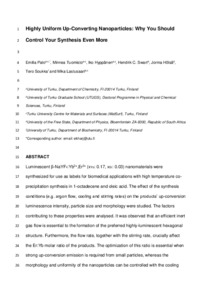| dc.contributor.author | Emilia Palo | |
| dc.contributor.author | Hendrik C. Swart | |
| dc.contributor.author | Iko Hyppänen | |
| dc.contributor.author | Jorma Hölsä | |
| dc.contributor.author | Mika Lastusaari | |
| dc.contributor.author | Minnea Tuomisto | |
| dc.contributor.author | Tero Soukka | |
| dc.date.accessioned | 2022-10-27T12:20:43Z | |
| dc.date.available | 2022-10-27T12:20:43Z | |
| dc.identifier.uri | https://www.utupub.fi/handle/10024/157959 | |
| dc.description.abstract | Luminescent beta-NaYF4:Yb3+,Er3+ (X-Yb: 0.17, X-Er: 0.03) nanomaterials were synthesized for use as labels for biomedical applications with high temperature co-precipitation synthesis in 1-octadecene and oleic acid. The effect of the synthesis conditions (e.g. argon flow, cooling and stirring rates) on the products' up-conversion luminescence intensity, particle size and morphology were studied. The factors contributing to these properties were analysed. It was Observed that an efficient inert gas flow is essential to the formation of the preferred highly-luminescent hexagonal structure. Furthermore, the flow rate, together with the stirring rate, crucially affect the Er:Yb molar ratio of the products. The optimization of this ratio is essential when strong up-conversion emission is required from small particles, whereas the morphology and uniformity of the nanoparticles can be controlled with the cooling rate. These results emphasize the importance of controlling the synthesis conditions, especially when nanoparticles need to have a specific morphology because of their use e.g. as luminescent labels in medical diagnostics. (C) 2017 Elsevier B.V. All rights reserved. | |
| dc.language.iso | en | |
| dc.publisher | ELSEVIER SCIENCE BV | |
| dc.title | Highly uniform up-converting nanoparticles: Why you should control your synthesis even more | |
| dc.identifier.urn | URN:NBN:fi-fe2021042716723 | |
| dc.relation.volume | 185 | |
| dc.contributor.organization | fi=PÄÄT Biotekniikka / DI|en=PÄÄT Biotechnology / DI| | |
| dc.contributor.organization | fi=kemian laitoksen yhteiset|en=Department of Chemistry| | |
| dc.contributor.organization | fi=kestävän kehityksen materiaalien kemia|en=Kestävän kehityksen materiaalien kemia| | |
| dc.contributor.organization-code | 2606203 | |
| dc.contributor.organization-code | 2606300 | |
| dc.contributor.organization-code | 2606302 | |
| dc.converis.publication-id | 20518455 | |
| dc.converis.url | https://research.utu.fi/converis/portal/Publication/20518455 | |
| dc.format.pagerange | 125 | |
| dc.format.pagerange | 131 | |
| dc.identifier.eissn | 1872-7883 | |
| dc.identifier.jour-issn | 0022-2313 | |
| dc.okm.affiliatedauthor | Hyppänen, Iko | |
| dc.okm.affiliatedauthor | Lastusaari, Mika | |
| dc.okm.affiliatedauthor | Palo, Emilia | |
| dc.okm.affiliatedauthor | Soukka, Tero | |
| dc.okm.affiliatedauthor | Tuomisto, Minnea | |
| dc.okm.discipline | 114 Physical sciences | en_GB |
| dc.okm.discipline | 116 Chemical sciences | en_GB |
| dc.okm.discipline | 221 Nanotechnology | en_GB |
| dc.okm.discipline | 114 Fysiikka | fi_FI |
| dc.okm.discipline | 116 Kemia | fi_FI |
| dc.okm.discipline | 221 Nanoteknologia | fi_FI |
| dc.okm.internationalcopublication | international co-publication | |
| dc.okm.internationality | International publication | |
| dc.okm.type | Journal article | |
| dc.publisher.country | Netherlands | en_GB |
| dc.publisher.country | Alankomaat | fi_FI |
| dc.publisher.country-code | NL | |
| dc.relation.doi | 10.1016/j.jlumin.2016.12.051 | |
| dc.relation.ispartofjournal | Journal of Luminescence | |
| dc.year.issued | 2017 | |
